https://www.youtube.com/watch?v=pF9Zsk0r2y0
Live Fire Steak
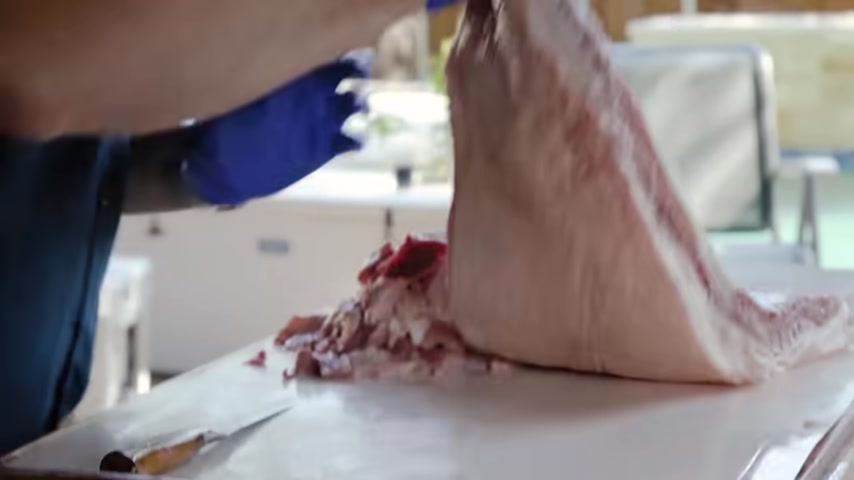
Hey guys , it's Matt with Meat Church .
And welcome back to my outdoor kitchen today .
I thought we'd kick it old school and grill a rib eye over an open fire .
I was a steak lover before I was a barbecue lover .
And when I first started cooking outdoors , I didn't know how to cook the perfect steak .
I did all that stupid stuff like what's medium , medium rare , watched every video I could find .
And then , you know , one day I figured out an instant thermometer is how you nail the perfect doneness or desired internal temperature of a steak .
But there's lots of ways to get there .
And we've got videos on different ways to cook steaks .
And I promise you every time I cook a steak , it's never like the time before .
So for instance , you could say reverse sear a steak .
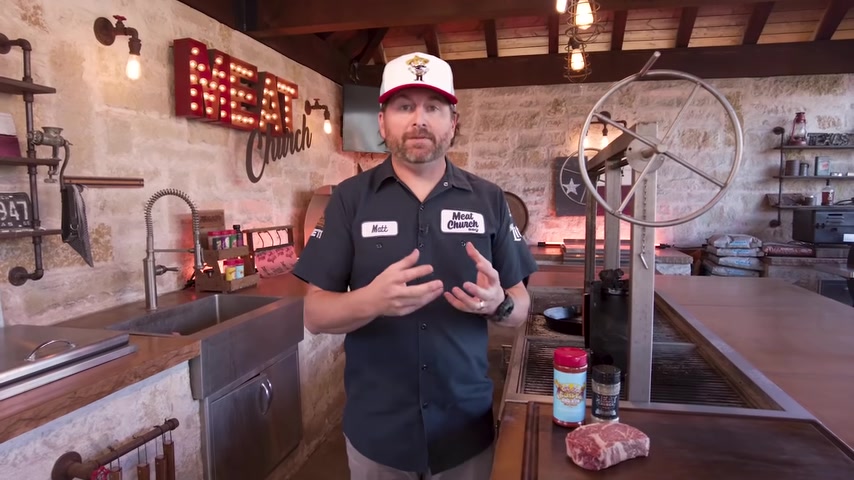
That's a method where you smoke the steak to impart some smoky flavor and then you sear it hard at the end .
Uh You might use , say a cast iron skillet to cook your steak in .
Lots of people will do these inside or even outside .
They'll put their steak in .
They'll bust based with butter with garlic and herbs and things like that .
Um , if you cook in sc a competitions , you grill steaks on grill grates , um , a high heat anna aluminum that , that can put beautiful diamonds on a steak .
You might sue via steak .
Um , you could smoke a steak lately .
I've seen lots of people with , you know , small ovens like auto wild ovens that , um , will cook a steak at 1500 degrees .
Like a steakhouse .
They're all great and different .
Have pros and cons .
But before you can do any of that , you need to know the basics of how to grill a steak over an open fire .
And that can help get you into all those other methods .
You might be out camping with nothing but fire and a grate .
Um , you might have a , a propane grill at home .
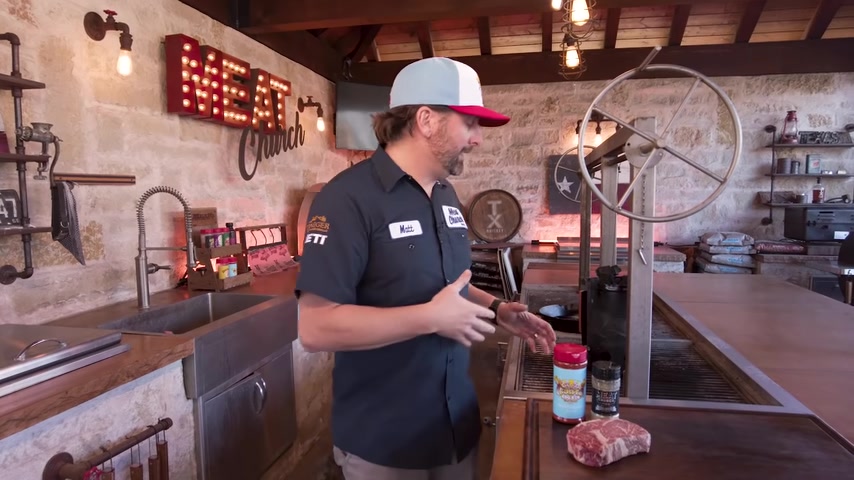
Who knows this method today will help you ?
Um , if that's your preferred method .
So , what we're doing today is we're just cooking over a direct fire .
We're on my custom Santa Maria grill .
This part isn't all that important , but when I built my outdoor kitchen , I had a vision that the Santa Maria would be the center of the kitchen that everyone would gather around .
There's a bar out here where you can hang and watch what I'm cooking , but this is nothing more , uh , than a hole with , uh , with lump charcoal in it and wood .
So , what we've done is we've put some lump down in the bottom .
Uh , there's some wood as well and then , uh , we've got a chimney of more lump that I've watered up some of our butcher paper , put some oil on it , lit it and , uh , we're waiting on , uh , this charcoal to completely catch and then we're gonna dump it in .
Uh , we're gonna burn this down .
Get a , not a nice hot fire .
That's gonna be definitely north of 500 degrees if you care about temperature .
Um We can raise this great up and down .
We're not gonna do that today .
We're just gonna move the steak around .
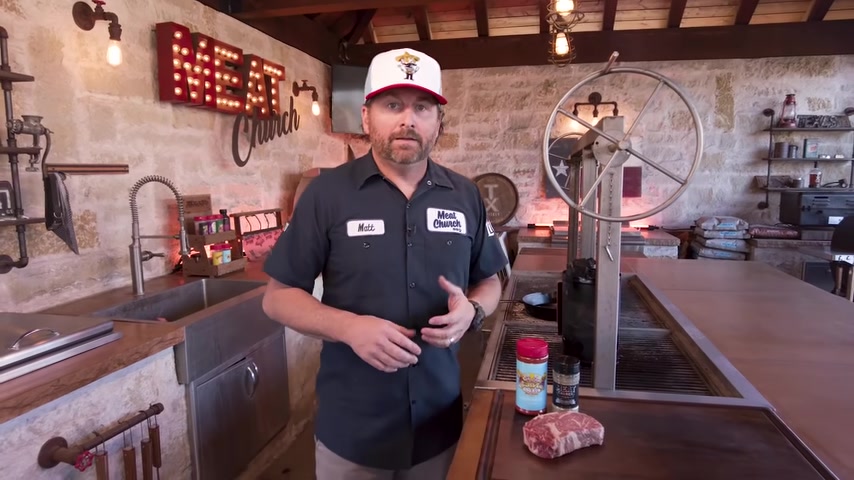
Uh And it's gonna be delicious .
One of the pros of this method would be , you might just like the taste of , you know , that fire imparting flavor uh directly into the steak .
So we're going super basic .
This is old school .
You don't have to have this fancy Santa Maria .
Um I've seen people take these chimneys and put a cooking grate over it and cook the steak just like that .
So , the important thing here is how to treat the meat , how to check it along the way and how it tastes at the end .
So let's jump in .
Uh I'm gonna sim I'm gonna season this really simply , but you gotta start with amazing meat .
Thanks to my friends at 44 farms down in Cameron , Texas .
They provided uh the steak for today .
This is a rib eye .
Uh It's a never ever product .
So that means no hormones or antibiotics .
Whether or not you use their steaks or someone else's , it's important to know how the cattle was treated .
So , you know what you're feeding your family .
That's why I choose this for me .
But this steak is gorgeous .
Look , this gigantic spinalis , which is why I chose this one .
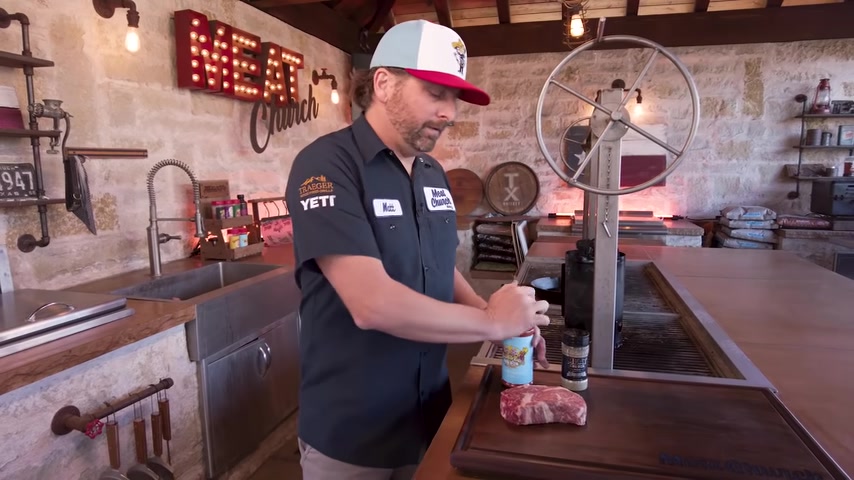
This steak is like almost , I don't know , 40% spinalis or cap out here .
So it's gonna , it's gonna be super good .
I'm gonna layer two flavors today .
I'm going with our Holy Gospel and our garlic and herb .
Uh Always start with your , when you're layering , always start with your more coarse rub .
And why is that ?
So the big peppercorns in here , you want those two adhere , you don't want them to bounce off all sides .
You could use a binder if you want like an olive oil .
You know , I just padded this dry .
I don't think a binder is necessary , but it's ok if you want to use an oil or shire or something like that , that's , you know , perfectly suitable .
By the way , the Holy Gospel .
It , you know , it is not traditionally our steak rub .
You guys know that our holy cow is what we normally use .
But uh I got a buddy Jack Arnold that uses this on steaks for a well-known running back uh for the Carolina Panthers .
And after I tried it , I was like , man , that's delicious .
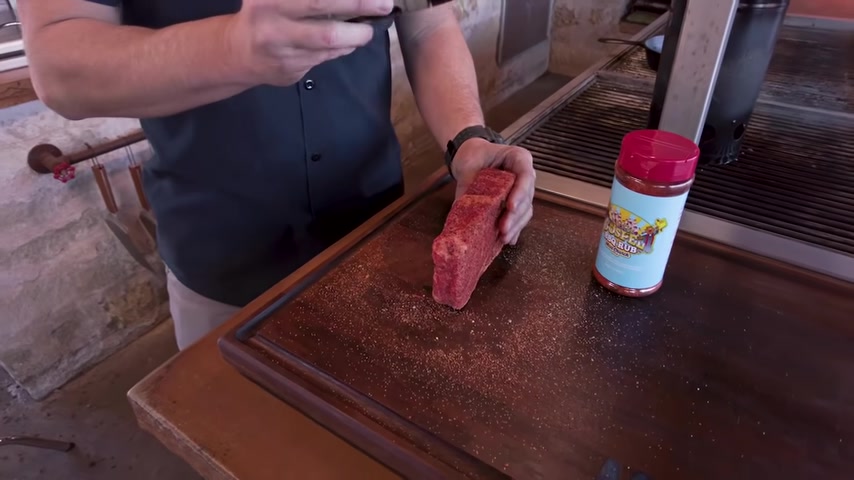
Has a touch of sugar in it , which I used to think sugar was kind of a no , no on beef , but I really like it .
And over this direct fire it's gonna caramelize pretty good .
So I'm coming back across that with that meat church gourmet garlic and herb .
This is a delicate rub so you can put a lot on it and , and then that's that I always like to use the board to kind of get the edges a little more .
And I wanna let this seasoning adhere or sweat out as .
So they say I'm gonna let this sit for 15 minutes would be fine if you wanted to do this for like , say up to an hour before you cooked it .
Um , but I'm gonna give this 15 minutes , uh , and we'll be back , we'll get this fire rocking and rolling and we'll get to cooking .
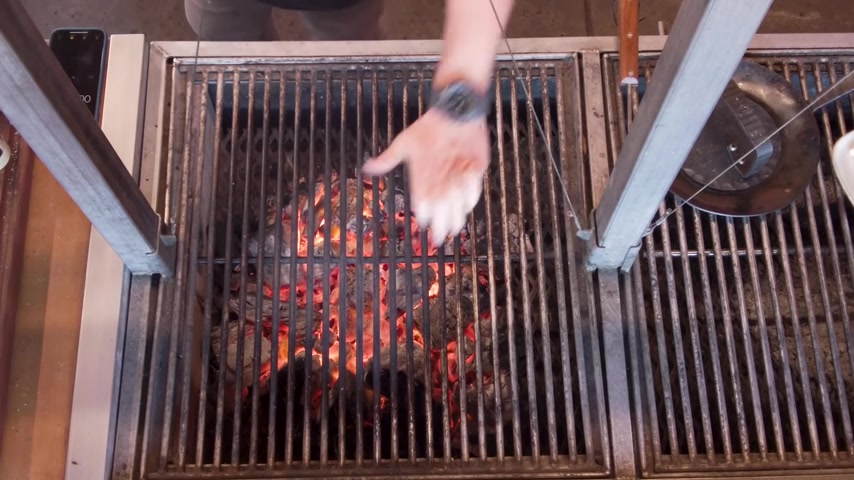
So this isn't just a recipe video .
Let's teach you to cook a little bit .
I could temp these , uh , the grill grate , but I can tell you it's hot .
So let's say you're out in the woods and you don't know the temperature , use your hand .
This is pretty hot .
It's super hot over the middle .
I can't hold my hand there more in a few seconds .
My guess is the middle is probably close to 1000 degrees .
I'm gonna cook out here on the outside of this fire to start with .
So I'm gonna go ahead and get my steak here .
And what I'm trying to do is I'm gonna go a couple of minutes aside to try to cook it nice and even listen , that sizzle , press it down on that grate .
Now , what I wanna do to cook this nice and evenly , I'm gonna cook this minute and a half , couple minutes on this side and then I'm gonna flip it over and I'm gonna do the same thing on the other side and I'm gonna tell you up front , depending on your cooking .
Great .
This isn't gonna be the most beautiful presentation .
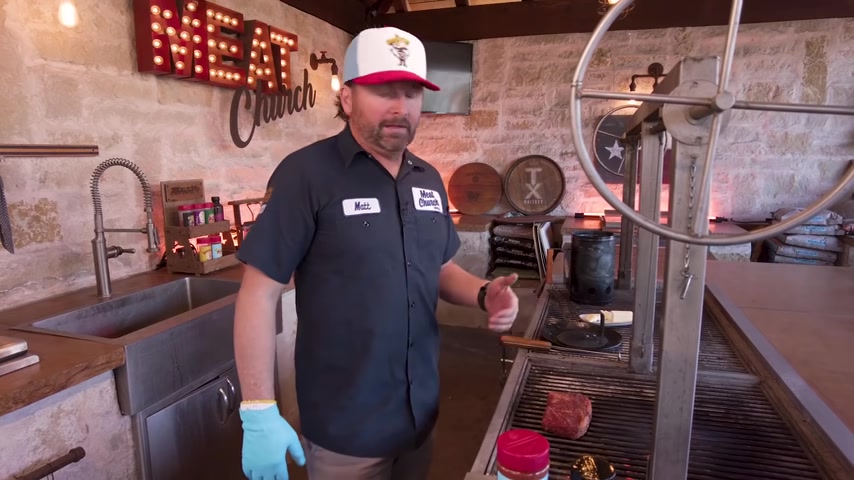
This is cooking on stainless steel bars are just vertical here .
They're not diamonds , not anything pretty .
I could spin this a minute in 45 degrees and make beautiful diamonds .
In fact , I may do that just to show you , but we're going to kind of flip this over after those first four minutes , we're gonna flip it every 45 seconds or minute again just to help it cook really evenly .
And the presentation isn't gonna be like the prettiest thing we can make .
And that's ok .
I'm running a timer over here on my iphone that I obviously started a little bit late .
We think it's been 30 40 seconds .
So use your trusty uh timer here and let's just let this cook .
I'm gonna see if we can get to two minutes .
I'm gonna flip it over again just to help it cook nice and evenly and let it keep rolling .
If you want to put some added pressure on it , you can put a little weight .
This is a , this is a burger press .
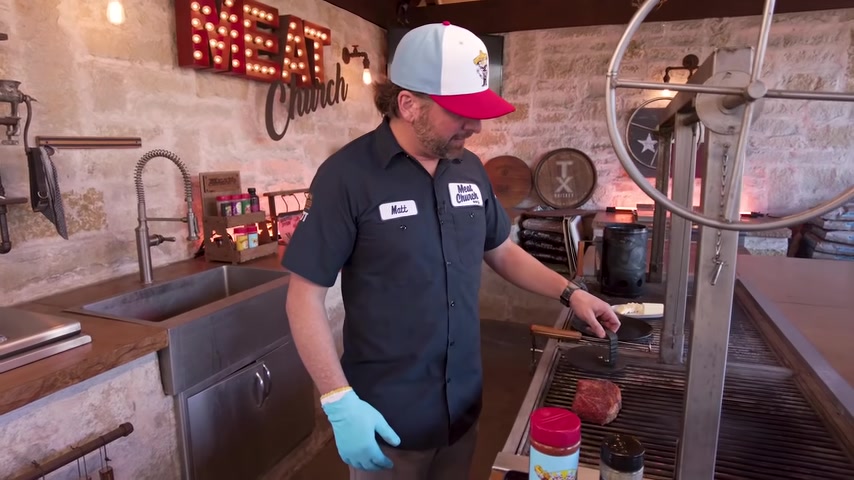
I have from Iron Grove .
Beautiful hand forge .
If you want to keep some weight on it , if you're worried about your presentation , if you're worried about your diamonds , but this is , this is gonna be really , really hot .
So , uh I don't have to worry too , too much about that .
If you guys wanna see what the diamonds will look like , we can turn this about 45 degrees .
I'm gonna put it on a new piece of metal , press it down to finish out that first two minutes .
You could use one of these pigtails to flip .
I got this insulated glove .
All right .
There we go .
Rib eyes are interesting because they got that fat in the middle .
So I wanna help them kind of keep shape there .
But you can see that nice char on there .
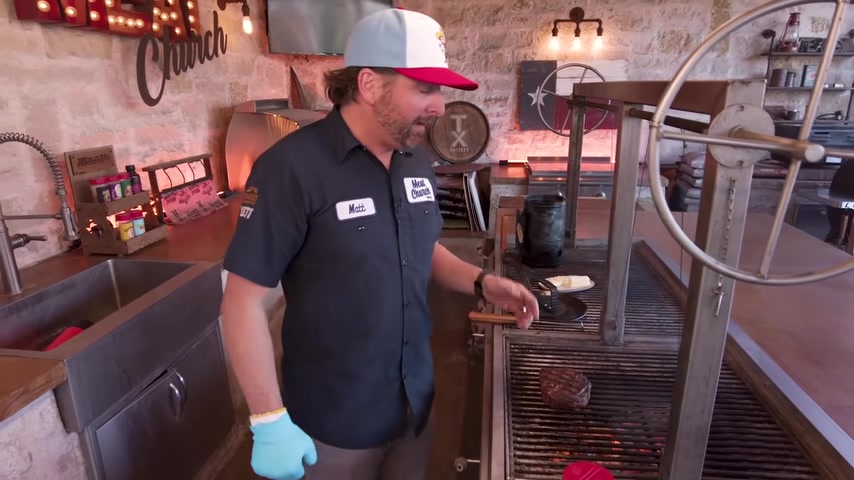
Uh Those charred bits are flavor and what I love .
So we're gonna go upwards of two minutes on this side and then we're just gonna turn this thing every which way until we get to our desired temperature .
I like my steak medium rare , which is 1 30 to 1 35 .
That means I need to pull this steak between 100 and 20 125 degrees internal right in the middle .
When I pull it , it'll carry over cook till get till we get right in that medium rare range .
Uh , and we'll rest it with some butter over here while that's happening .
All right , we've been just at four minutes .
Let's flip it again .
Now , I'm gonna basically gonna turn this thing every different direction .
I like to go on new pieces of the metal .
You don't have to do that .
But again , it's super hot here .
So I'm gonna kind of stay on the perimeter of that fire and let's use our instant read and check right in the heart of this state .
We're at 74 degrees .
So we've got a little bit to go .
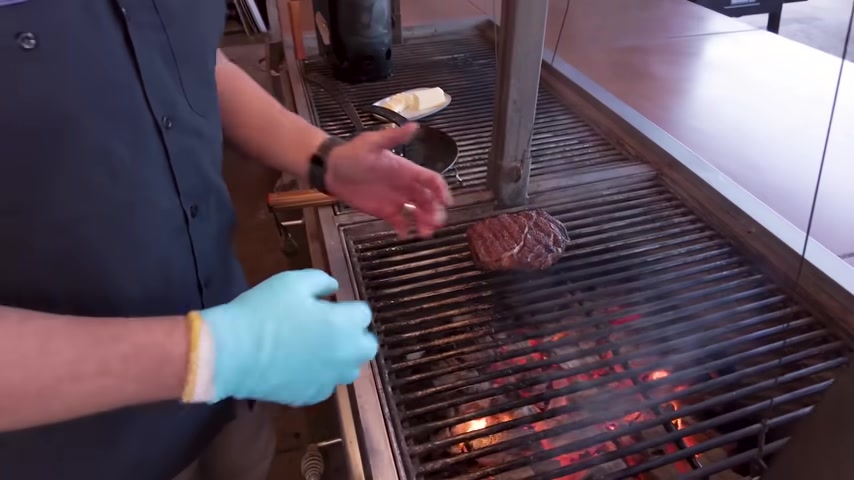
So we'll be able to flip , you know , do what you want , but I'm gonna try to flip it probably every 45 seconds or so .
Just get those nice charred bits all over this steak .
So you can see this side didn't get as many as much char .
So I'm gonna , now on this flip , I'm gonna go , let's go over the hot part right there .
Oh , that's hot already .
Smells good with that fat dripping down in that fire .
All right , this is super hot .
So I'm gonna bust in my spatula here flip again and there's some that got some char on at that time , for sure .
All right , we've been another 45 seconds .
So now kind of for the rest of the steak , I'm gonna stay out here on the edge .
So the cooler part of the fire and grill to let that thing come up to Tim .
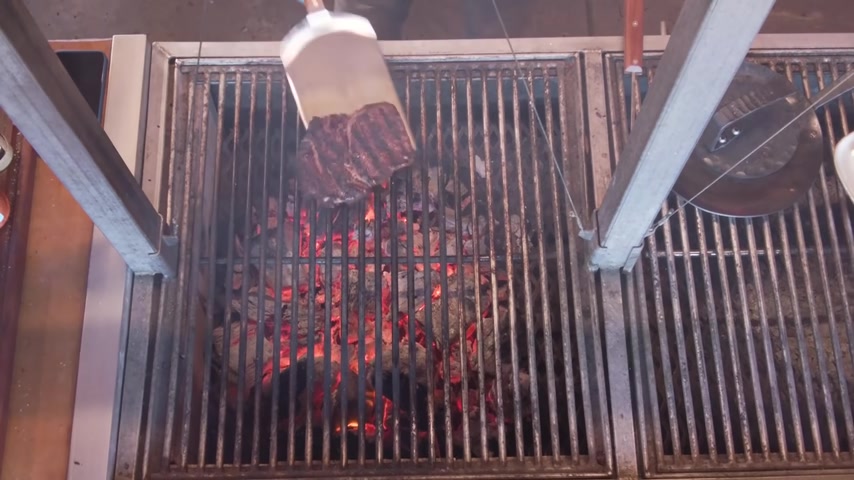
All right , we're gonna go one last flip .
I try to go this other direction .
Not only am I flipping it , but I'm also spinning it because I think we're just about there .
Use your instant re thermometer to get right in the heart .
All right , we're done .
I'm gonna rest this on this pan .
Oh , that looks good .
Now , I like to rest my steaks with a little bit of butter .
This is unsalted butter , nice and plain .
You could use a compound butter .
I don't think it's a huge deal if you use salted butter , but there's a lot of salt in the seasoning .
So I'm going with this , I'm gonna put it over here where it's cool and we'll see y'all back here and I don't know , 10 minutes when it's time to eat .
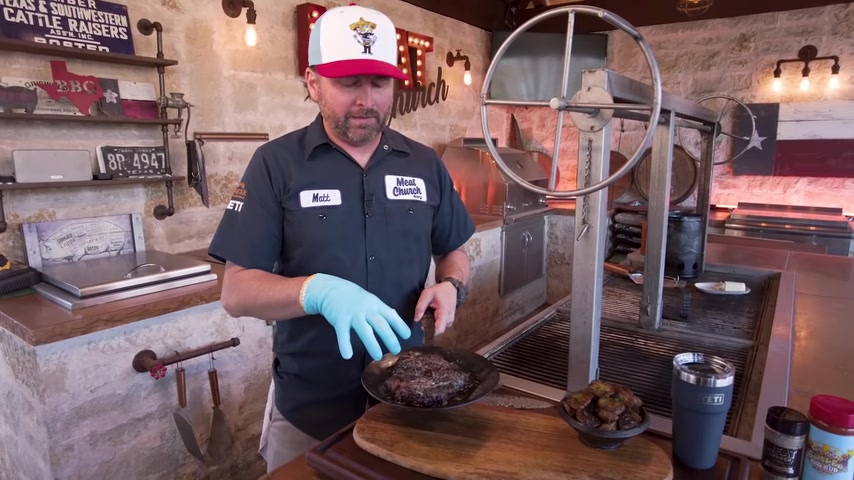
All right guys , this steak has rested for about 10 minutes .
You can see the butter melted over it .
Uh The , you that's important to let it rest because the juices will kind of redistribute throughout the steak .
Um So that way you won't cut into it and all those juices run out and rob yourself of a really juicy bite like I always say , plus this has been sitting in this pan and this butter .
So it's gonna be delicious .
Let me , I'll talk to you about a little , a little side dish here .
So check out these potatoes super easy .
So I cut up some really small gold potatoes , have them uh parboiled them for like eight minutes .
Uh And then I coated them in olive oil and meat .
Church garlic and herb threw them in the trigger for 30 minutes at 400 degrees on a pan .
And let me tell you something about these .
This is a great easy side .
They're fluffy , but they're also crispy .
Gotta make those .
I'll put the recipe down below .
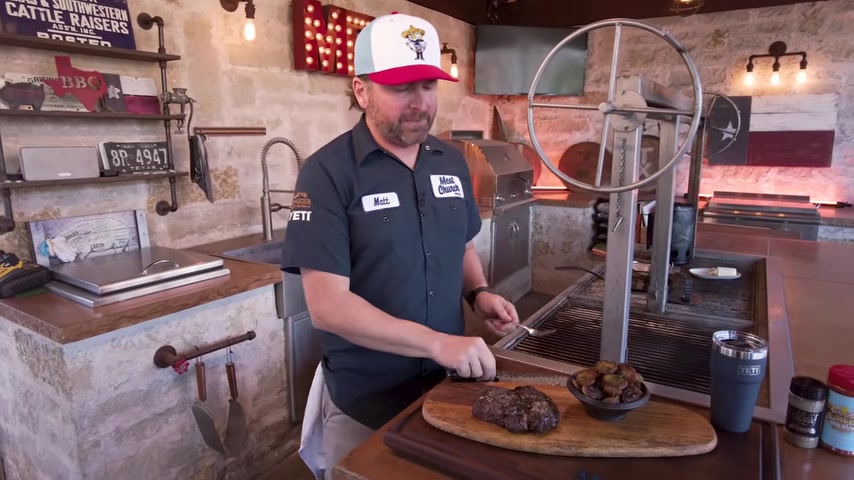
All the recipes are always in the description .
Uh and they're also always on meat churchch dot com .
But let's see how we did .
I mean , look at this steak .
You got this gigantic spinalis huge .
I'm gonna start right here .
We were temping right here in this portion .
So that's where we're gonna start .
See how we did look at that .
That's a beauty is a OK with me and you can see it's cooked really evenly .
I'm gonna go and get me a little bite here .
Let's see how we did 10 more tender than your mother's love my dog .
She knows what's up .
All right .
Only because I love you .
All right .
So that's that part .
Let's get over here in the spinal .
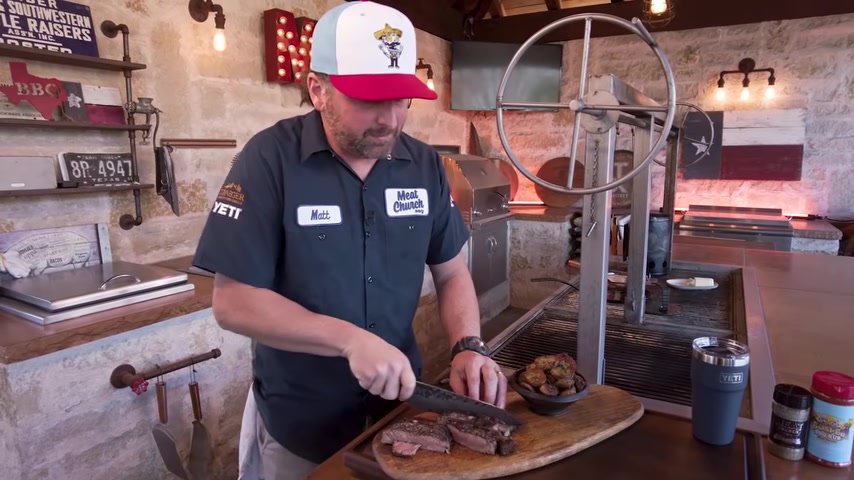
That's the good stuff , right ?
If you're , if you're splitting a steak with your wife , this is a part , you give your wife and this is a part you keep for yourself .
My wife doesn't watch my videos .
So she doesn't know that that's what I do but spin that open .
Look at that spinalis man .
This is gonna be so tender right here .
This is crazy .
Can make easy work of this with my new Iron Grove knife .
Thanks Daniel golly .
I don't know what y'all are gonna have .
Good Lord .
I'm gonna need a minute .
So I love the flavor from the seasoning .
I'm just gonna say that on the meat church .
You're gonna compliment your seasonings .
But um I , like I said earlier , I used to not put any sugar on beef .
I love that cooked directly over that open fire .
Really just with your senses and the instant red thermometer moving it around constantly .
You can see that it's cooked perfectly evenly all over the steak .
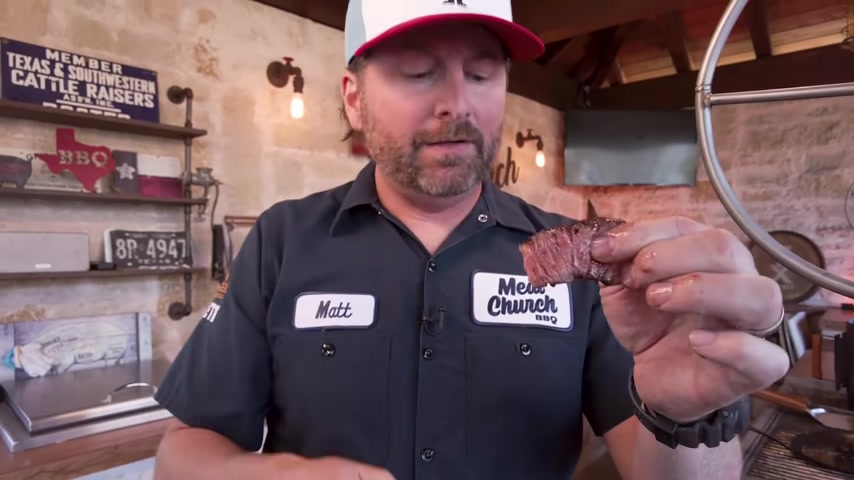
I mean , I'll show you both sides of that and , you know , I love all the different ways of , of cooking steak , but there's just something about the primal nature of just cooking that directly over fire and the flavor you get from that .
That's tough to beat my friends .
If you guys dig what we do , please like and subscribe to the channel .
Our team's working hard to bring you .
No shtick , straightforward how to cooking videos every week .
See y'all next time .
Are you looking for a way to reach a wider audience and get more views on your videos?
Our innovative video to text transcribing service can help you do just that.
We provide accurate transcriptions of your videos along with visual content that will help you attract new viewers and keep them engaged. Plus, our data analytics and ad campaign tools can help you monetize your content and maximize your revenue.
Let's partner up and take your video content to the next level!
Contact us today to learn more.